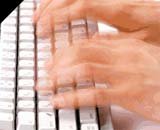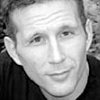So often the field of strength and conditioning remains enslaved to a highly mechanistic approach to training goals. However, we live in a subjective world, flooded with changing emotions, fluctuating energy levels, "mysterious" pains, and surprise stressors.
Everyone at some time in their lives has experienced fluctuations of some kind among common variables: lifting the same weight twice can seem heavier, running the same distance can seem longer, resting the same duration can seem shorter, etcetera. The subjective experience of training differs from the numbers we etch into our training journals.
In my book on Circular Strength Training? I refer to the Rating of Perceived Effort (RPE): how maximal you perceive your session's training load. Listing your RPE in your journal gives a more accurate assessment of your progress so you may modify your program to better accomplish your goals.
If you want to prevent burn-out over-training and injuries, and if you want to continue to make positive results indefinitely, then your RPE should be one of the key factor in your program assessment.
How Do You Design RPE Into Your Program Assessment?
 If you have a set/rep/time scheme, add in RPE into your after action report. You can do this with a basic light-moderate-heavy reference, a five-star system (5 being max), or you can fine-tune it to a 10 point scale (10 being max) as suggested in my book. Rather than trying to remember the perceived effort of each repetition, draw your RPE from the overall set experience.
If you have a set/rep/time scheme, add in RPE into your after action report. You can do this with a basic light-moderate-heavy reference, a five-star system (5 being max), or you can fine-tune it to a 10 point scale (10 being max) as suggested in my book. Rather than trying to remember the perceived effort of each repetition, draw your RPE from the overall set experience.
Then, average the entire session. If you don't want to record the RPE of each set, just pick out the hardest sets of the entire session to remember. Record that RPE as your total experience of the session.
How Does Recording Your RPE Help Your Program?
Are you interested in achieving your program's projected results, or are you interested in achieving your true potential? Say your program has you listed to hit the same numbers over 4 sessions before increasing the intensity. The target for the session is actually supposed to be 70%RM (85 percent of the weight you could lift for one repetition.) The objective 70%RM should conceivable pair up with your subjective 7 RPE (if on a 1-10 scale). However, at the 2nd session, you realize that you're cruising through the exercise with an RPE of 4. Do you need to continue or do you alter your session to meet your current potential?
Say your program has you consistently going up in reps or weight over each session. However, each session you're being outstripped and fall farther and farther behind. Do you change your program, or struggle to put out the numbers?
Intuitive Training uses your RPE as a means of plugging into the most elusive characteristic in physical training: your constantly changing biorhythm. Traditional S&C presumes that you can apply its numbered goals to any time of the day, any day of the week, any season of the year, any temperature, air pressure, weather condition, humidity level, etc... However, some times are better for you than they are for others. Add in your emotional climate to the mix, and you have a highly personalized pattern to assess and reassess.
A few "professionals" out there demand that you must have some increase in each session you train. Linear progression looks great on paper; however this just isn't the case neurologically when some aspects of development take longer to latch-on than others. Rigid number fixation cannot accommodate the impact that your sport and your life in general have upon your time devoted to strength & conditioning.
For instance, if your one rep maximum you attempted felt very demanding (a 9-10 on your RPE on a 1-10 scale), you may decrease the load by 20lbs and do a few more sets of 2 reps each. Then increase by 10lbs for another few single rep sets. The same example can apply to timed running, to volume lifting and to rest period compression.
So All I Need Is My RPE To Use My Intuition In Training?
No. What happens when you push beyond your threshold? Your technique deteriorates. Your goal must always be to stop at the last repetition you can do with proper form. Why?
If you force a fluid through a hose, it comes out the end in a forceful stream. Now, take an ice pick, poke holes in the hose. Bend the hose in kicks. Place heavy objects at different places of the hose. Finally, wind & wrap the hose around a few obstacles. What's the water pressure like coming out now? Dribbles, I'm sure. If the hose were sentient, it would probably think to itself, "the pressure inside me is so great, but what I'm producing is terribly small." This is how many people train.
Watch the grimacing gym rats who scream through sloppy form. They'll tell you that it's the effort that counts. How often are they riddled with injuries covered with straps, wraps and belts? How often do they complain of aches and pains? And most obviously, how far have they actually progressed in physical development over the years of this "method" of work? Effort without technique cannot sustain progression. You burn out or break down without fanatical ascription to form.
So How Can Intuitive Training Help You Assess Form?
 Coupling RPE, maintain a record of your Rating of Technique (RT) - the "Effective Efficiency" of the form you use for your exercises. Concentrate your actions to the actual performance goals of the exercise, and keep vigilant against superfluous tension and movements. The accuracy of your technique is in direct proportion to the results you create. Like the analogy of the hose - proper form focuses your effort into a high pressure stream.
Coupling RPE, maintain a record of your Rating of Technique (RT) - the "Effective Efficiency" of the form you use for your exercises. Concentrate your actions to the actual performance goals of the exercise, and keep vigilant against superfluous tension and movements. The accuracy of your technique is in direct proportion to the results you create. Like the analogy of the hose - proper form focuses your effort into a high pressure stream.
The greater that focus, the more significant your results while minimizing any break-down in the container (the hose - in this case YOU!) Form loss is most generally connected to overtraining or deficient training, but in most cases is attributed to lack of monitoring technique. Consider Rating of Technique refers to the notion of making your training into "practice" - every training you should focus on refining your skills.
One's subjective experience of the technique can vary from one session to the next, so it's periodically beneficial to video tape yourself to objectively evaluate your form. Compare your RPE with the objective accuracy of your form. Intuitive Training will help you balance the subjective experience (RPE) with the objective framework (RT).
Your RT will also help you determine if you're prepared for a more sophisticated exercise. Only progression to more challenging skills when you've stabilized above 70-80% in your RT (Zone-by-Zone Mastering of Intensity Matveyev, 1977). Otherwise, you'll be building your house on sand. Refine your current skill before sophisticating it.
Your RT will also communicate the reliability of your technique. If you're smart, you're not just training, you also either enter competitions, or set personal records you must break under certain conditions. If your competitive RT is lower than your training RT then you may need to explore methods of controlling your emotional arousal and increasing your mental toughness. Here are a few suggestions:
- Remove factors which distract you from learning and refining your technique (such as mirrors, music and people.)
- Prevent yourself from moving prematurely into more sophisticated skills
- Master mental toughness and emotional control of the tasks which bring you the greatest challenge and fear. (Siff, Supertraining p322)
Here is a general graph on how to structure your training diary to include Intuitive Training's RPE and RT:
| Set 1 | Set 2 | Set 3 | Set 4 | Set 5 | RPE | RT | |
| Exercise 1 | |||||||
| Exercise 2 | |||||||
| Exercise 3 | |||||||
The late Dr. Mel Siff referred to Intuitive Training as Cybernetic Periodization (Supertraining p322) to reinforce the constant feedback, reassessment and redesign of training as it occurs.
Copyright RMAX.tv Productions
NOTE: All of the terminology herein is the sole coined intellectual property of RMAX.tv Productions. Coach Sonnon coined the above terms and trademark protected them. Because you read the following does not give you the right to call the terminology or descriptions your own work and misrepresent Coach Sonnon's long history of experience, research and development since 1989. What is written above involves Coach Sonnon's SPECIFIC SYSTEM and his trademark protected intellectual property.
Yours in strength,
CLUBBELL® is a registered trademark of RMAX.tv Productions, and "Clubbells" word and "Circular Strength Training" phrase are trademarks of RMAX.tv Productions.
